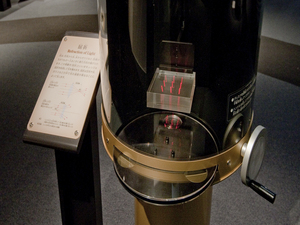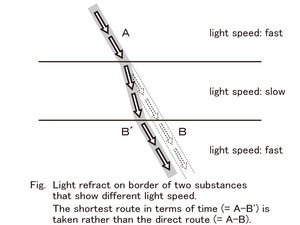Nagoya City Science Museum
TOP > Exhibition Guide > Keyword Search > Starting with "F" > focal point > Refraction of Light
Refraction of Light



Purpose of Exhibition
This exhibition gives you a chance to observe the phenomenon that happens when light is bent by a lens.
Additional Knowledge
Lenses gather and broaden lights, utilizing light refraction.
A single lens is a magnifying glass, but by combining multiple lenses, it becomes a space telescope or a microscope. .
[The reason why lights refract]
When light enters into different substances, from the air through water, from water through glasses, etc., its moving direction is distorted. This phenomenon is called "refraction". Refraction is caused by the fact that light speed differs in each substance. Light speed is said to be 300 thousand km per second, but this is within emptiness. In the water, light speed slows down, to 226 thousand km per second. This difference of speed causes the phenomenon of refraction. Light when going from one point to another point takes the shortest route.
If speed doesn't change in the middle, a direct line drawn between the two points may be the shortest route. If speed changes in the middle, however, a direct line drawn between the two points may not always be the shortest route.
It could take less time in total for light to go a longer distance at a faster speed, and a shorter distance only at the slower speed.
Light makes a choice of such a route and proceeds, refracting when entering into a substance. [Sound is refracted, too] The phenomenon of refraction also exists with sound.
The reason why you can hear a train crossing a bridge at a distance in the evening is sound refraction. The cold air is on the surface of the earth in the evening and the warm air high above the sky. Because of this, speed of sound changes according to the different temperature of the air, the sound progression is diffracted, and the sound headed for the sky heads back to the ground.
Thanks to this, you hear sound at a distance occasionally, which you cannot hear during the daytime. The phenomenon of light refraction has been well known since ancient times.
In 300 BC, the mathematician Euclid once wrote about an experiment, where objects placed at the bottom of a container could be seen by pouring water into it, even when hidden by the rim.
It was Snell in the 17th century in Holland that articulated the formula of refraction properly. Snell's formula is one of the most important formulas to be learned in physics class in senior high school. The law of refraction was explained based on the wave theory of light by another Holland- born physicist Huygens, born three years after Snell's death. Huygens' Principle is also a very important principle on waves transmission taught in school.
It is still taught in schools today, therefore the law of refraction explained by Huygens is correct. At that time, there was also another theory proposed by the famous discoverer of universal gravitation Newton, according to which light was not a wave, but particles.
He explained that when diffraction occurs, too, light particle speed changes in the water.
However, as for this change of speed, the wave theory states that it is slower in the water than in the air. The particle theory states it is faster. Now it is known that the light speed is slower in the water than in the air.
We know that Newton was wrong.
Until the late 19th century, Newton's theory of light was completely denied. After that, with the development of physics, today it can be explained that light is made of waves and particles.
Article by Yoshitaka Yamada, curator
